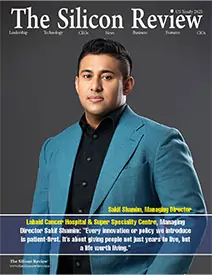>>
Technology>>
Cloud>>
The Shift to Smart SDKs: How B...The Shift to Smart SDKs: How Built-in Observability Is Transforming Cloud Database Interactions
The Silicon Review
07 November, 2024
- Baha Aiman
When a cloud application slows down or crashes, every second counts. Teams scramble to identify whether issues stem from the client, the network, or the database, while user frustration and costs mount.
Software Development Kits (SDKs) were once simple connectors that quietly ferried requests between applications and databases. However, in modern cloud-native environments, speed alone isn’t enough; applications require full visibility into every interaction.
Over years of building and maintaining cloud database SDKs, I’ve seen them evolve from silent bridges into intelligent tools with embedded observability. By surfacing client-side metrics, performance diagnostics, and real-time signals directly from the SDK, we can close long-standing visibility gaps, accelerate troubleshooting, and deliver the reliability that modern systems require.
The Visibility Gap in Cloud Database Interactions
Traditional monitoring ends at the database, leaving developers blind to client and network behavior. These gaps delay fixes and allow issues to reach users before they are detected.
A survey on observability in distributed, container-based microservices highlighted this challenge, showing how teams often struggle with fragmented visibility. Distributed tracing can help link events across client, network, and server. But most SDKs still do not provide traces or metrics by default. Developers end up guessing at failures from the symptoms instead of diagnosing the real cause with data.
The difference between monitoring and observability becomes clearest when visualized. The framework below shows how observability builds on monitoring to uncover hidden issues in complex systems. While monitoring checks known conditions, observability reveals unknown failures and dependencies.![]()
For SDKs, embedding telemetry at the client layer makes this shift practical. Without it, developers remain blind to the root causes of system failures and delays.
Intelligent SDKs as the Solution
Smart SDKs transform how developers fix issues by surfacing previously invisible signals. These insights significantly enhance the identification and resolution of performance problems. These include operation and attempt latency, application-blocking delays, retry counts, and connection-level failure diagnostics.
In 2023, the Bigtable SDK at Google Cloud introduced client-side metrics, exposing latency and retry information that had previously been hidden. Developers could now pinpoint whether delays came from the application, the network, or the backend.
The value of client-side observability is evident from projects led in senior technical roles. One enterprise-scale customer struggled with hourly latency spikes that traditional monitoring failed to uncover. By embedding client-side metrics and implementing preemptive SDK-level optimizations, diagnosis time dropped from hours to minutes.
In systems where uptime is critical, observability does more than solve problems. It protects user trust.
The trend is not limited to one platform. The Azure Cosmos DB team has evolved its Java SDK to include request-level diagnostics and configurable timeout policies. This reflects an industry-wide shift. SDKs have evolved from passive tools to active stewards of system health.
The diagram below shows where retries, application-blocking delays, attempt latencies, and operation latencies are measured across the client–service–database lifecycle.
![]()
These metrics, when exposed directly in the SDK, provide developers with the necessary context to determine whether issues originate from the client, the network, or the backend service. This closes the loop that traditional monitoring often leaves open.
Key Impact Areas of Smart SDKs
Smart SDKs with built-in observability have a wide-ranging impact:
- Smart SDKs accelerate debugging by surfacing latency origins and error patterns earlier in the request lifecycle.
- They support proactive optimization, allowing teams to adjust client behavior in real-time before it affects users.
- Built-in observability strengthens resilience by revealing retry patterns and failover failures.
- By illuminating client-side delays, SDKs enable developers to deliver smoother and more consistent user experiences.
Standards like OpenTelemetry have catalyzed this shift by providing a unified framework for collecting logs, metrics, and traces.
During my work on SDK development, I found that adopting common standards made integrations easier. These standards also encouraged collaboration across teams working with different database services. In effect, they turn observability into a shared language that SDKs can use across platforms.
In one project, proactively implementing client-side authentication token refreshes in a database SDK eliminated recurring latency spikes for a customer. The outcome demonstrated that observability at the SDK level does more than surface data. It equips developers with the insight and control to implement targeted fixes before users notice a problem.
Why This Shift Matters for Developers and Organizations
The rise of intelligent SDKs offers a strategic advantage. Developers gain independence from backend logs, resolving issues faster. For organizations, this enhances system reliability. Observability becomes a design cornerstone, not an afterthought.
According to the CNCF OpenTelemetry Project Journey Report, OpenTelemetry adoption is now widespread, proving that the industry is embracing standardized observability at scale.
Meanwhile, a study on microservices observability emphasizes how logging, metrics, and tracing together drive discovery and performance management. SDKs are ideally positioned to generate and expose these signals. This makes them powerful allies in building data-driven cultures around application reliability.
What the Future Holds for SDK Observability
![]()
Looking ahead, smart SDKs will continue to transform the developer experience. Key trends include:
- Advanced on-device diagnostics: SDKs will provide deeper insights into client behavior, including offline and edge use cases.
- Adaptive client behavior: SDKs will tune retries, concurrency, and timeouts based on real-time metrics.
- Predictive insights: Machine learning trained on SDK telemetry could flag issues before they reach users, enabling proactive resilience.
The McKinsey Technology Trends Outlook 2023 reinforces that cloud and edge computing are foundational to next-generation software. As these architectures scale, intelligent SDKs will become indispensable.
Having designed and delivered observability features that directly impact customer outcomes, I envision a future where SDKs serve not only as conduits but also as intelligent partners. They will learn from metrics and help applications recover on their own.
From Invisible to Indispensable: The New Role of the SDK
SDKs are no longer passive tools; they are critical observability instruments that help developers debug faster, optimize proactively, and build resilient systems. Designing these capabilities taught me one clear lesson: the SDK is now indispensable to application health and reliability.
For engineering leaders and developers, the question is simple: are your SDKs surfacing the metrics and diagnostics you need for full observability? If not, you are operating blind. The future of cloud reliability depends on seeing the whole picture.
The next generation of software will be shaped not by speed alone, but by visibility and resilience. Smart SDKs are the foundation of that future.
About the Author
Baha Aiman is a software engineer with nearly a decade of experience designing and delivering scalable, resilient cloud database SDKs and client libraries. She specializes in observability, performance optimization, and developer experience.
References:
- Chui, M., Issler, M., Roberts, R. and Yee, L. (2023, July 30). The top trends in tech 2023. McKinsey Digital. https://www.mckinsey.com/capabilities/mckinsey-digital/our-insights/the-top-trends-in-tech-2023
- Cloud Native Computing Foundation (2023, October 20). OpenTelemetry Project Journey Report. CNCF. https://www.cncf.io/reports/opentelemetry-project-journey-report/
- CMG (2020, July). The complete guide to distributed tracing. Computer Measurement Group. https://www.cmg.org/wp-content/uploads/2020/07/the-complete-guide-to-distributed-tracing.pdf
- Evans, B. (2022, April 12). Observability 2022: Why it matters and how OpenTelemetry can help. Red Hat Developers. https://developers.redhat.com/articles/2022/04/12/observability-2022-why-it-matters-and-how-opentelemetry-can-help
- Fu, M. and Jacobson, B. (2023, March 24). Client-side metrics for Cloud Bigtable. Google Cloud Blog. https://cloud.google.com/blog/products/databases/client-side-metrics-for-cloud-bigtable
- Madupati, B. (2023, November 30). Record 13951033. Zenodo. https://zenodo.org/records/13951033
- Usman, M., Ferlin-Reiter, S., Brunstrom, A. and Taheri, J. (2022, July). A survey on observability of distributed edge and container-based microservices. IEEE Access, 10(3): 77155–77180. https://www.researchgate.net/publication/362154081_A_Survey_on_Observability_of_Distributed_Edge_Container-based_Microservices
- van Kraay, T. (2023, July 18). Latest NoSQL Java ecosystem updates 2023 Q1 & Q2. Microsoft Developer Blogs. https://devblogs.microsoft.com/cosmosdb/latest-nosql-java-ecosystem-updates-2023-q1-q2/
 (1)_2025-10-21_13-35-14.webp)


_2025-10-02_10-21-48.webp)


